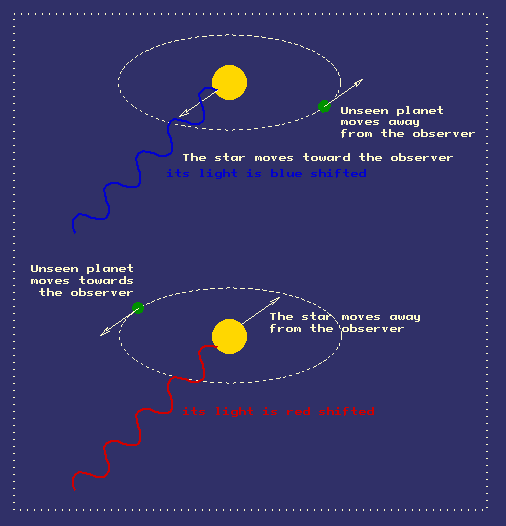Describe in Detail Two Techniques Used to Find Extrasolar Planets
We find two plausible triple-planet models that fit the data both having a second planet near P 840. Jamie Machtmes _____ _____ Extrasolar Planets Remember to type your answers in blue text Background Material Complete the following sections after reviewing the background pages entitled Introduction Center of Mass The Doppler Effect and Detecting ExtraSolar Planets.

Extrasolar Planet Detection With The Afoe
Three massive planetslikely larger than Jupiterwere directly.

. Since 2002 more than 20 extrasolar planets have been discovered on average each year. Tap card to see definition. As of 2006 around 200 extrasolar planets had been identified using the radial velocity technique.
It is up to you to decide which planets to use and how to make them. Typically the mass of the planet m p is small enough to ignore. The mission will also discover previously unknown planets around some of these stars using the technique of transit-timing variations.
How to Search for Exoplanets. The sole Bruno conjecture that remains unconfirmed is the one about the ubiquity of life. As of April 2016 582.
As we shall see in the next paragraphs for solar-type stars this can be used to try to detect planets using two different techniques. Describe two methods that have already been used to study extrasolar planets and which one gives us the most information. But in the rare cases where the jovian transits.
Describe the three main methods used to find exoplanets. Since October 2006 according to the IAU thanks to new indirect observational techniques 208 extrasolar planets have been discovered with masses ranging from that of Jupiter to the upper size limit for a planet about 15 Jupiter masses. During the past 10 years various planet detection techniques have been used to find more than 200 exoplanets.
Place the cardboard divider between your teams so the Kepler Science Team cannot see the orrery. Finally as I will describe in detail below it is only two decades ago that the first few extrasolar planets were discovered and only within the last few years that it has become clear that planets are common around other stars. You dont have to use all three but try to make it challenging.
The second-most-used path to discovering exoplanets is via Doppler spectroscopy sometimes called the radial velocity method and commonly known as the wobble method. Access the lab content at Name. When the exoplanets gravity affects them.
Three other techniques that have detected extrasolar planets are pulsation timing microlensing and direct imaging. Astronomers have discovered two planets using NASAs Kepler telescope. But these methods all have limitations.
Therefore scientists rely on indirect methods like looking at the stars themselves for signs that planets might be orbiting them. The first extrasolar planet discovered around a sunlike star was announced on October 6 1995. A super Earth inferno and its Neptune-like companion.
The early radial-velocity. Extrasolar planets are planets that orbit stars other than our Sun. In a few rare cases astronomers have been able to find exoplanets in the simplest way possible.
Even through a powerful ground- or space-based telescope stars look like tiny points of light. Any planet is an extremely faint light source compared to its parent star. Planets are even tinier and are very difficult to spot next to their bright host stars.
Since then astronomers have been discovering extrasolar planets at a dizzying rate and the list of all the known extrasolar planets contains more than 500 new worlds. In the boxes provided label the positions on the. Most have been detected by the Doppler shifts they induce in the motion of their home stars with the periodicity of these shifts telling us their periods.
The first successful detections of extrasolar planets orbiting main-sequence stars were made via the radial-velocity method which favours discovery of massive planets in close orbits around their host stars. Regular Patterns of blueshift and redshift. Other techniques used to discover exoplanets not employed by Cheops are.
Overview of methods of detecting exoplanets. Pulsation timing measures the change in distance between the signal source and the telescope by using the arrival times of signals that are emitted periodically by the source. However then m p is large and m s is small it does have a noticable effect.
In this paper we describe the major techniques used to search for extra-solar planets. This effect gives the possibility to indirectly detect a planet orbiting another star by simply measuring this dynamical effect. SA Click card to see definition.
For direct transit measurement to be possible for extrasolar planets the orbit of the extrasolar planet must be aligned so that the planet will pass between Earth and the star. Using the various planet choices create a solar system consisting of up to three planets. Number of extrasolar planet discoveries per year through 2022 with colors indicating method of detection.
When the planet passes between the star and the Earth it causes a minute drop to be seen from Earth in the intensity of the light from the star. The average separation of the planet and star a is simply the sum of the radii for circular orbits. We will describe the various observational techniques that are used to detect extrasolar planets and to study them in greater detail from thermal emission to atmospheric characterization.
The knowledge and tools NASA has developed to study life on Earth will be a great asset to the study of planets beyond our solar system. Of the planets found orbiting other stars many show signs of a much more dynamical past than our Solar System. Most infer the existence of a planet through its.
When exoplanets move across the star the brightness is reduced.

What Is The Radial Velocity Method Universe Today

No comments for "Describe in Detail Two Techniques Used to Find Extrasolar Planets"
Post a Comment